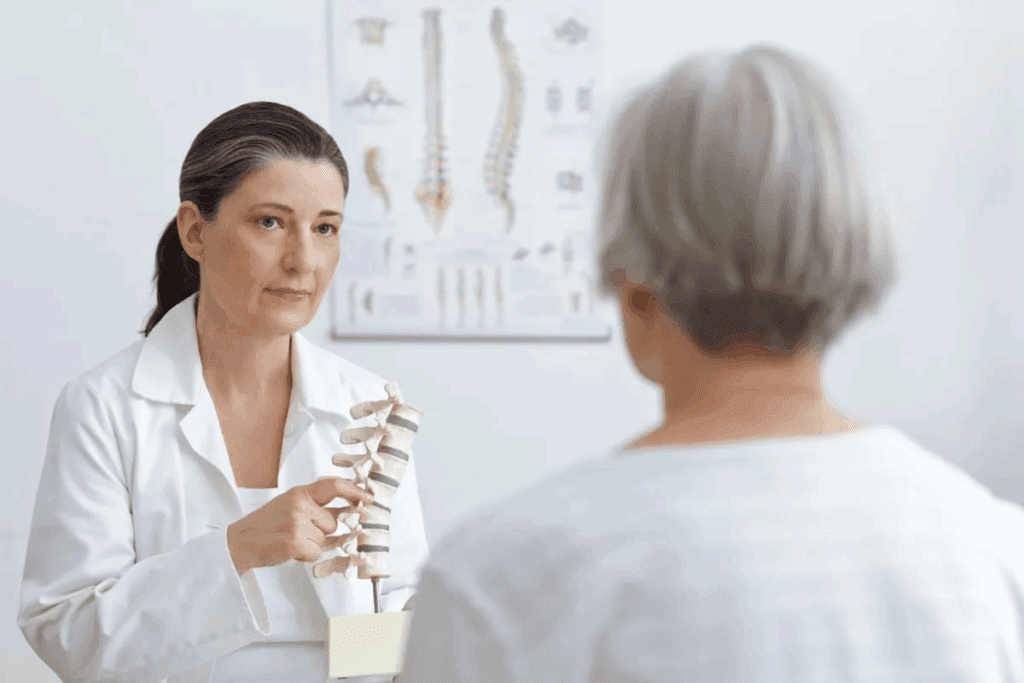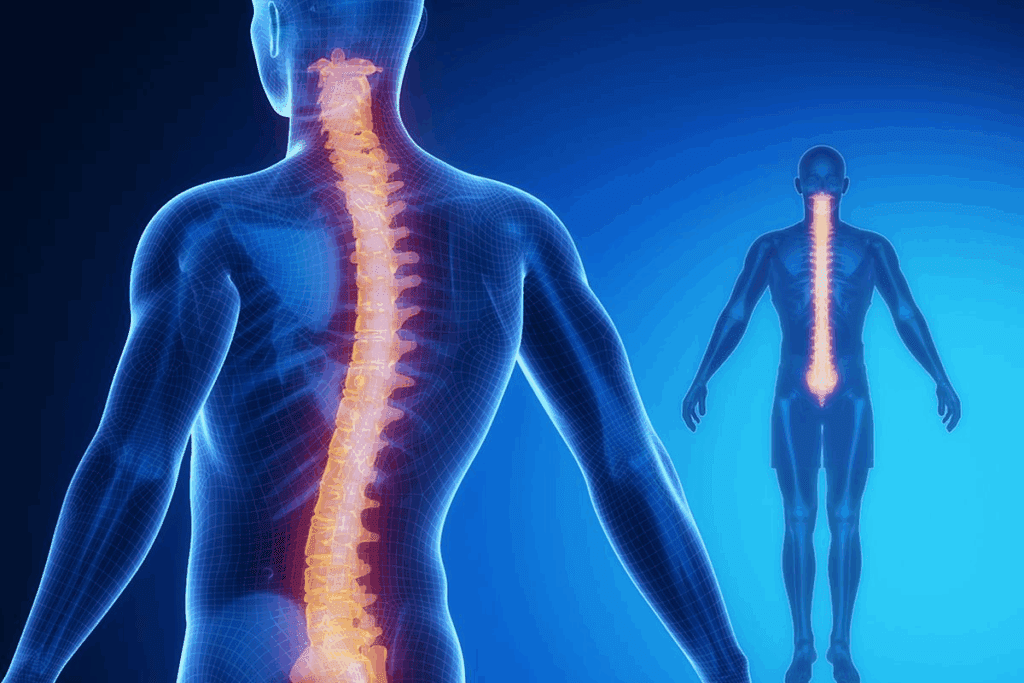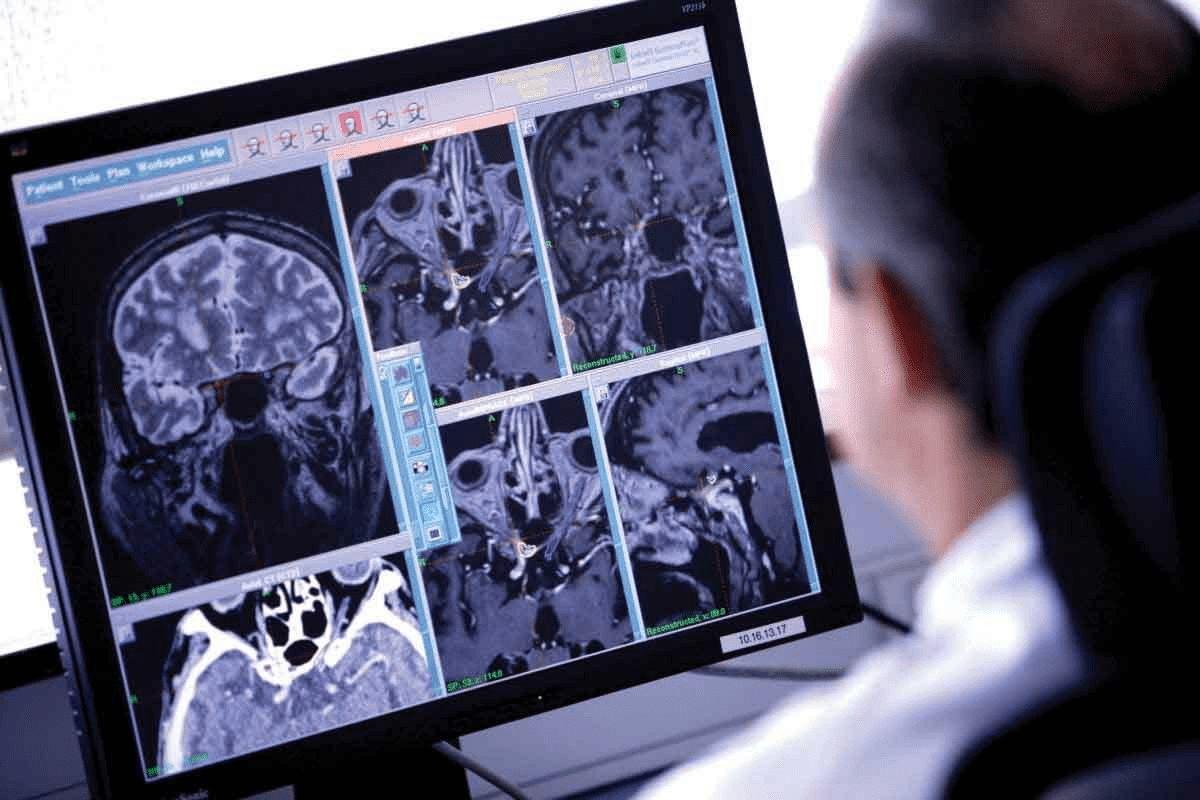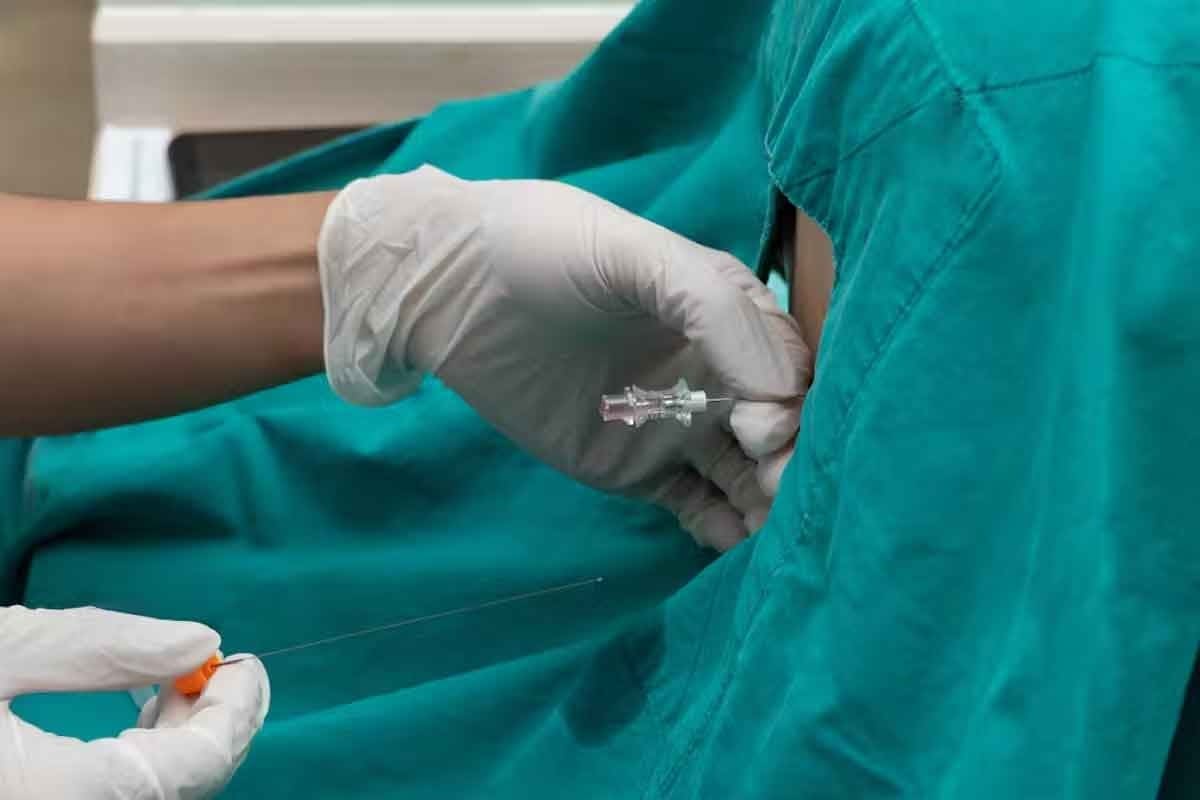Last Updated on November 26, 2025 by Bilal Hasdemir

Chronic back pain can really hurt your life quality. If usual treatments don’t work, a spinal cord stimulator (SCS) might help. It’s a new way to manage pain by putting electrodes and a power source in your body.
SCS stops pain signals from reaching your brain. This gives relief to those with long-term back pain. Liv Hospital is all about top-notch care and new ideas in treating pain.
Key Takeaways
- A spinal cord stimulator is a neurostimulation treatment for chronic back pain.
- SCS involves the surgical implantation of electrodes and a power source.
- Electrical impulses delivered via SCS interrupt pain signals to the brain.
- Liv Hospital offers patient-centered innovation in spinal stimulation therapy.
- Spinal cord stimulation is a non-pharmacological treatment option.
The Challenge of Chronic Back Pain Management

Managing chronic back pain is a big challenge in healthcare. It affects patients’ quality of life in many ways. It impacts their physical abilities and emotional well-being.
The Prevalence and Impact of Persistent Back Pain
Chronic back and lower extremity pain are major causes of disability worldwide. These conditions greatly affect people’s quality of life and productivity. Back pain that lasts can make it hard to move and do daily tasks.
“Chronic pain is a major public health issue that requires a multifaceted approach to management and treatment.” This shows how complex chronic back pain is. It needs a detailed care plan.
Limitations of Conservative Treatment Approaches
Traditional treatments for chronic back pain include medicine, physical therapy, and lifestyle changes. But, these methods have their limits. Many patients find these treatments don’t fully manage their pain, leading them to seek more effective solutions.
- Medication limitations: It can lead to dependency, side effects, and not work for everyone.
- Physical therapy constraints: It might not work for all back pain types, and results vary.
- Lifestyle changes: They are helpful but hard to stick to.
The Need for Advanced Interventional Solutions
The limits of traditional treatments show the need for new pain management methods. Spinal cord stimulators, like electric back pain devices, are being used more. They help with chronic back pain that doesn’t respond to other treatments.
“The advent of spinal cord stimulation technology has revolutionized the way we approach chronic back pain, giving new hope to patients who have tried everything else.”
Exploring new interventional solutions helps healthcare providers offer better pain management. This improves patients’ quality of life and ability to function.
Spinal Cord Stimulators: Advanced Pain Devices for Back Pain Relief

Spinal cord stimulators are a new way to treat chronic back pain. They send electrical impulses to the spinal cord. This stops pain signals before they reach the brain.
The idea of spinal cord stimulation started in the 1960s. But, big improvements have made these devices much better.
Definition and Basic Functionality of SCS Systems
SCS systems, or spinal stimulators, are implantable devices that send electrical impulses to the spinal cord. They have a small generator, leads, and electrodes. These work together to send targeted stimulation to the spinal cord.
Evolution of Spinal Stimulation Therapy
SCS systems have changed a lot over time. At first, they were simple and not very effective. But, new technology has made them better and safer.
Improvements in lead design, pulse generator technology, and programming have helped. Now, SCS systems offer many options for personalized treatment.
Key Components of Modern Stimulator Systems
Today’s spinal cord stimulators have several important parts:
- The pulse generator: This is the power source that makes the electrical impulses.
- Leads: These are insulated wires that carry the impulses to the electrodes.
- Electrodes: These are the points of contact that send the stimulation to the spinal cord.
The table below shows the main parts and what they do:
| Component | Function |
| Pulse Generator | Produces electrical impulses |
| Leads | Transmits impulses to electrodes |
| Electrodes | Delivers stimulation to spinal cord |
These parts work together to control the electrical impulses. This makes spinal cord stimulation therapy more effective for managing chronic back pain.
The Neuroscience Behind Spinal Cord Stimulation for Pain Control
Spinal cord stimulation (SCS) is a key method for managing pain. It sends electrical impulses to the spinal cord. This helps control pain signals.
Gate Control Theory and Pain Signal Interruption
The gate control theory is key to SCS’s effectiveness. Ronald Melzack and Patrick Wall introduced it in 1965. It says certain nerve fibers in the spinal cord act as “gates” for pain signals.
SCS therapy works by sending electrical impulses to these fibers. This stops pain signals from reaching the brain. Studies show it can greatly reduce chronic pain in those who’ve tried other treatments.
Modulation of Inhibitory Neurotransmitters
SCS also affects inhibitory neurotransmitters, which help control pain. Research shows SCS boosts neurotransmitters like GABA. GABA stops pain signals from being sent.
“The modulation of inhibitory neurotransmitters by SCS contributes to its efficacy in managing chronic pain,” notes a study published in the Journal of Pain Research.
This effect not only helps with pain relief but also makes SCS therapy more effective over time.
Neuroplasticity and Long-term Pain Relief Mechanisms
Neuroplasticity is another important factor in SCS. It’s the brain’s ability to create new connections. Chronic pain can cause bad changes in the brain. SCS can help change these pathways for better pain management.
| Mechanism | Description | Effect on Pain |
| Gate Control Theory | Activation of large-diameter afferent nerve fibers | Interrupts pain signal transmission |
| Modulation of Inhibitory Neurotransmitters | Increased release of GABA | Enhances pain inhibition |
| Neuroplasticity | Beneficial rewiring of pain pathways | Promotes long-term pain relief |
Understanding these mechanisms helps doctors tailor SCS therapy for each patient. This improves outcomes and enhances quality of life.
Types and Technologies of Modern Spinal Implants for Pain
The world of spinal cord stimulation has changed a lot. Now, there are many options for pain relief. Modern spinal implants are made to help people with chronic pain in a way that fits them best.
Traditional Tonic Stimulation Systems
Traditional tonic stimulation systems are key in spinal cord stimulation therapy. They send constant signals to the spinal cord to block pain. Tonic stimulation helps with many types of chronic pain, like back pain.
Burst Stimulation Technology
Burst stimulation technology is a big step up from traditional methods. It sends short bursts of energy, which can work better for some. This tech can give significant pain relief with fewer side effects.
High-Frequency Stimulation Options
High-frequency stimulation is getting more attention for its pain relief. These systems use higher frequencies than usual. They offer improved pain relief for some, and are good for those who didn’t get better with other treatments.
Dorsal Root Ganglion Stimulation
Dorsal root ganglion (DRG) stimulation targets the dorsal root ganglion, a key pain transmitter. It’s very effective for complex regional pain syndrome and other specific pain issues.
Today, there are many spinal implant technologies for pain management. This means doctors can tailor treatments to fit each patient’s needs. This approach could lead to better pain relief for everyone.
The Spinal Stimulation Procedure: From Evaluation to Implantation
The spinal stimulation procedure starts with patient selection. This step is key to making sure the treatment works well and is safe for the patient.
Patient Selection and Candidacy Assessment
Choosing the right patients is vital for spinal cord stimulation therapy to work. People with long-term back pain that hasn’t gotten better with other treatments are usually good candidates. Doctors look at the patient’s health history, current condition, and past treatments to decide if it’s right for them.
- They check how bad the pain is and how long it’s lasted.
- They look at what treatments the patient has tried before.
- They also consider if anything in the patient’s mind might affect their pain.
This detailed check helps doctors figure out if spinal cord stimulation is a good choice for the patient.
The Trial Period with Temporary Leads
Before getting a permanent implant, patients try out spinal cord stimulation with temporary leads. This step lets doctors see if it really helps with pain.
During this trial, temporary leads are put near the spinal cord. The patient wears a temporary stimulator. They then tell doctors how much pain relief they get.
- The temporary leads are put in under local anesthesia.
- The patient is watched for a few days to see if the pain goes down.
- If the pain does go down a lot, the patient is likely to get a permanent implant.
Permanent Implantation Surgical Techniques
If the trial works, the patient gets a permanent implant. This means surgically putting in the spinal cord stimulator device and leads.
The surgery involves:
- Putting the leads near the spinal cord under X-ray guidance.
- Placing the pulse generator (the stimulator device) in the buttock or abdomen.
- Running the leads under the skin to connect them to the pulse generator.
The surgical techniques for permanent implantation need a lot of skill. This ensures the device and leads are placed just right.
Targeting Specific Pain Regions with Back Stimulator Devices
Spinal cord stimulation technology has improved a lot. Now, it can target pain areas precisely. This makes pain relief more effective. Back stimulator devices can be set up to focus on specific pain spots, giving patients therapy that fits their needs.
Lumbar Stimulators for Lower Back Pain Relief
Lumbar stimulators are made for the lower back. They help those with chronic lower back pain. By placing the stimulator leads in the lumbar area, patients see a big drop in pain.
Lumbar stimulators are great for people who didn’t get better with other treatments. They offer a new way to handle lower back pain.
Cervical Stimulation for Upper Back and Neck Pain
Cervical stimulation focuses on the upper back and neck. It helps those with chronic pain in these spots. Modern spinal cord stimulators work well to manage pain.
Cervical stimulation is good for pain that goes to the arms or is from cervical radiculopathy. Doctors can adjust the stimulation to get the best pain relief.
Precision Lead Placement for Optimal Coverage
The success of back stimulator devices depends on precision lead placement. Getting the leads in the right spot means better pain relief.
Doctors use imaging during the implantation to place the leads perfectly. This is key for the best results.
Being able to target specific pain areas with back stimulator devices is a big step forward in managing chronic pain. Tailoring therapy to each person’s needs means better pain relief for everyone.
SCS Stimulator Batteries and Power Management
Understanding SCS stimulator batteries is key for those thinking about this treatment. The success of Spinal Cord Stimulation (SCS) for pain depends on its power source.
Rechargeable vs. Non-rechargeable Battery Systems
SCS devices use either rechargeable or non-rechargeable batteries. Rechargeable batteries are popular for their long life and ease of use. They can be charged outside the body, cutting down on replacement needs.
Non-rechargeable batteries last less and need to be replaced surgically. Though once common, newer tech makes rechargeable batteries a better choice.
| Battery Type | Lifespan | Rechargeability | Surgical Replacement |
| Rechargeable | Up to 15 years | Yes | No |
| Non-rechargeable | 2-5 years | No | Yes |
Battery Lifespan and Replacement Considerations
The life of SCS batteries differs based on type and use. Rechargeable batteries can last up to 15 years with proper care. Life span is affected by settings, use frequency, and charging habits.
For non-rechargeable batteries, replacement surgery is needed. Patients should talk to their doctor about what to do when the battery runs out.
Managing and Minimizing Spinal Cord Stimulator Battery Pain
Some may feel pain from the SCS battery, known as spinal cord stimulator battery pain. Adjusting settings or moving the battery can help.
New battery tech has made SCS devices more comfortable and long-lasting. Patients should team up with their doctors to get the most from their SCS system and avoid discomfort.
Programming and Optimizing Electric Stimulators for Back Pain
Electric stimulators can really help with back pain if they’re set up right. It’s all about the programming and how the patient can adjust it. Getting the spinal cord stimulation (SCS) device just right is key to feeling better.
Initial Programming After Implantation
Right after a spinal cord stimulator is put in, it needs to be set up for the patient. This means tweaking things like pulse width, frequency, and amplitude. The goal is to make sure the pain is covered well.
“The first goal is to give the patient a comfortable and effective stimulation,” says a top pain management expert. This setup happens in a clinic, where adjustments can be made on the spot.
Patient-controlled Settings and Adjustments
Today’s SCS systems let patients tweak their settings themselves. This means they can adjust the stimulation based on how they’re feeling or what they’re doing. It’s a big help in managing pain.
- Adjusting amplitude to manage pain fluctuations
- Changing stimulation modes for different activities
- Utilizing different programs for various pain areas
Having control over their SCS devices helps patients manage their pain better. It can really improve their life quality.
When to Seek Professional Reprogramming
While it’s great that patients can adjust their settings, sometimes a pro needs to step in. This is true if the pain changes a lot or if the current settings aren’t working anymore.
Here are some times when you should see a professional:
- If pain returns or gets worse despite changes
- When the pain area or intensity changes
- If the stimulation feels uncomfortable or unpleasant
Regular check-ins with a healthcare provider are important. They help make sure the SCS device is working its best to ease pain.
Comparing Spine Stimulator Implants to Other Pain Interventions
Looking at spine stimulator implants and other pain treatments shows a wide range of choices for those with chronic pain. These implants, also known as internal TENS units, are a special way to handle back pain.
Spinal Stimulators vs. External TENS Units
Spine stimulator implants and external TENS units both aim to ease pain with electrical signals. But they work in different ways. External TENS units use skin electrodes, while spine stimulator implants are surgically placed to directly stimulate the spinal cord.
This internal method might offer more focused and effective pain relief for some. A big plus of spine stimulator implants is they can give ongoing pain relief without needing an external device. This can be a big help for those who find external devices hard to use.
Advantages Over Traditional Pain Medications
Spine stimulator implants have clear benefits over traditional pain meds. One key advantage is they help reduce the need for pain meds. Many chronic pain patients rely on opioids, which can lead to addiction and side effects.
On the other hand, spine stimulator implants offer a pain management option without drugs. This is great for those who haven’t seen results from meds or want to avoid opioid risks.
Comparison with Other Interventional Procedures
Spine stimulator implants stand out when compared to other treatments like nerve blocks or steroid shots. They’re usually considered for those with chronic pain who’ve tried other treatments without success.
- Reversibility: Unlike some other treatments, spine stimulator implants can be turned off or removed if needed.
- Long-term efficacy: They can offer lasting pain relief, possibly reducing the need for more procedures.
- Customization: The device’s settings can be adjusted to fit each patient’s needs, providing a personalized pain management plan.
In summary, spine stimulator implants are a valuable option for chronic pain management. They offer unique benefits compared to other treatments. Understanding these differences helps patients and doctors choose the best treatment plan.
Conclusion: Advancements and Future Directions in Spinal Stimulation Therapy
Spinal cord stimulation therapy is getting better, giving hope to those with chronic back pain. New technology makes the treatment more effective and comfortable. This is good news for people who haven’t found relief with other treatments.
The future of spinal stimulation therapy is bright. Researchers are working hard to make it even better. We can look forward to more advanced devices and ways to use them, helping more people manage their pain.
Spinal stimulation therapy has already shown it can help a lot of people. With ongoing improvements, it will keep being a key part of treating chronic pain. It promises to bring relief and better lives to many who suffer from back pain.
FAQ
What is a spinal cord stimulator and how does it work?
A spinal cord stimulator is a device implanted under the skin. It sends electrical impulses to the spinal cord. This interrupts pain signals to the brain, helping to relieve chronic back pain.
What are the benefits of using a spinal cord stimulator for chronic back pain?
Spinal cord stimulators are a minimally invasive treatment for chronic back pain. They are reversible and adjustable. This reduces the need for pain medications and improves life quality.
What types of spinal cord stimulators are available?
There are several types of spinal cord stimulators. These include traditional tonic systems, burst stimulation, high-frequency options, and dorsal root ganglion stimulation. Each has its own benefits and characteristics.
How is a spinal cord stimulator implanted?
The implantation process starts with a trial period using temporary leads. Then, permanent leads are implanted surgically. The device is programmed to meet each patient’s needs.
Can a spinal cord stimulator be used for different types of pain?
Yes, spinal cord stimulators can target various pain areas. This includes lower back, upper back, and neck pain. Precision lead placement ensures optimal coverage.
What are the differences between rechargeable and non-rechargeable spinal cord stimulator batteries?
Rechargeable batteries last longer and reduce the risk of depletion. Non-rechargeable systems need periodic replacement. The choice depends on individual needs and preferences.
How is spinal cord stimulator battery pain managed?
Managing battery pain involves proper programming and adjusting settings. This minimizes discomfort. Options include recharging or replacing batteries as needed.
Can patients adjust their spinal cord stimulator settings?
Yes, patients can adjust settings using a patient-controlled device. This allows for personalized optimization of stimulation parameters for better pain relief.
How does spinal cord stimulation compare to other pain interventions?
Spinal cord stimulation offers a unique combination of efficacy, safety, and adjustability. It compares well to external TENS units, traditional pain medications, and other interventional procedures.
What is the future of spinal cord stimulation therapy?
Advances in spinal cord stimulation technology are expected. These include new stimulation paradigms and improved device design. This will continue to improve treatment outcomes and expand applications.
What is an internal TENS unit?
An internal TENS unit is a spinal cord stimulator. It is an implantable device that delivers electrical impulses to the spinal cord. It is similar to an external TENS unit but is implanted under the skin for chronic pain management.
How does a lumbar stimulator work for lower back pain relief?
A lumbar stimulator is a spinal cord stimulator designed for lower back pain. It delivers electrical impulses to the lumbar region of the spinal cord, providing relief from chronic pain.
What is the role of neuroplasticity in spinal cord stimulation?
Neuroplasticity is key in spinal cord stimulation. The therapy can lead to long-term changes in the nervous system. This contributes to sustained pain relief and improved treatment outcomes.
Reference:
- Mekhail, N., Levy, R. M., Deer, T. R., et al. (2021). Systematic Literature Review of Spinal Cord Stimulation in Chronic Pain: Clinical Effectiveness and Mechanisms of Action. Neuroscience Insights, 16, 1-15. https://www.sciencedirect.com/science/article/pii/S1094715921064321






